
Arrival
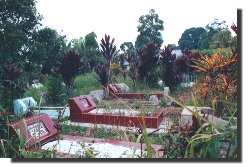 As we neared Bukittinggi, the scenery took a turn for the better. We were in the foothills, and then mountains of central Sumatra. The coconut farms gave way to rolling hills of terraced rice farms and random other crops. The farmland was dotted with small houses and resting shacks where the farmers spend their afternoons. We had entered the land of the Minang Kabau people, but we still had no idea
what that meant. There were mosques here and there and occassional tribal meeting house would catch the
eye. We started to see why the area is popular with tourists. Again, the bus dropped us off far from the city center with no directions concerning the bus station or other assistance. However, we managed to hail a minibus toward downtown Bukittinggi. Guesthouse row is right next to the "high hill" that gives the town its name. Euge, Natalie, and I got a room at the Singgalan for about four bucks, including unlimited coffee and tea. The proprietor gave us all the info we needed to enjoy the area and even signed us up for his buddy's village tour leaving the next day.
As we neared Bukittinggi, the scenery took a turn for the better. We were in the foothills, and then mountains of central Sumatra. The coconut farms gave way to rolling hills of terraced rice farms and random other crops. The farmland was dotted with small houses and resting shacks where the farmers spend their afternoons. We had entered the land of the Minang Kabau people, but we still had no idea
what that meant. There were mosques here and there and occassional tribal meeting house would catch the
eye. We started to see why the area is popular with tourists. Again, the bus dropped us off far from the city center with no directions concerning the bus station or other assistance. However, we managed to hail a minibus toward downtown Bukittinggi. Guesthouse row is right next to the "high hill" that gives the town its name. Euge, Natalie, and I got a room at the Singgalan for about four bucks, including unlimited coffee and tea. The proprietor gave us all the info we needed to enjoy the area and even signed us up for his buddy's village tour leaving the next day.
View this QTVR Panorama Image from a Bridge in Central Bukittinggi(226K)

Day Tour with Jon
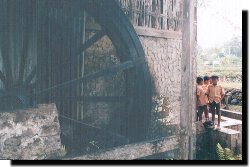 The morning started off with a breakfast including yet another banana shake at the Star Cafe. Then Jon, a friend of the owner there, came out and introduced himself to the six people who would be riding in his minivan for the day including Euge, me, Natalie, and even Keith who had arrived late yesterday via the evening bus. Jon told us many stories throughout the day, but I thought that one of the most interesting was the fact that he used to work at CalTex back in Pekanbaru. He was some kind of engineer/mechanic type who machined special parts for their equipment. He said the pay was amazing compared to almost anything else in Sumatra, but he got tired of the corporate life. It seems like very few people here have nine to five jobs. Many still work for themselves as farmers, drivers, shopkeepers, cooks, etc. Anyway, Jon started taking English lessons and got his certificate to be a tour guide. I sometimes wonder what they teach in these classes, because half of the tour tends to be propaganda about why the local area is so great. Anyway, Jon is from the Minang Kabau area originally, so he is quite proud of the place.
The morning started off with a breakfast including yet another banana shake at the Star Cafe. Then Jon, a friend of the owner there, came out and introduced himself to the six people who would be riding in his minivan for the day including Euge, me, Natalie, and even Keith who had arrived late yesterday via the evening bus. Jon told us many stories throughout the day, but I thought that one of the most interesting was the fact that he used to work at CalTex back in Pekanbaru. He was some kind of engineer/mechanic type who machined special parts for their equipment. He said the pay was amazing compared to almost anything else in Sumatra, but he got tired of the corporate life. It seems like very few people here have nine to five jobs. Many still work for themselves as farmers, drivers, shopkeepers, cooks, etc. Anyway, Jon started taking English lessons and got his certificate to be a tour guide. I sometimes wonder what they teach in these classes, because half of the tour tends to be propaganda about why the local area is so great. Anyway, Jon is from the Minang Kabau area originally, so he is quite proud of the place.
Local Tourism and Tour Guides
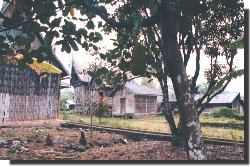 Although we are only miles from the equator, this area is pretty comfortable due to the altitude. The lush green hills make for some beautiful scenery and interesting daytrips. During the morning we drove a lot along small roads stopping to see a local farm, a coffee mill, and finally a king's palace. The agrigculture around here is just amazing. Jon would just break off some leaves from what seemed to be a
Although we are only miles from the equator, this area is pretty comfortable due to the altitude. The lush green hills make for some beautiful scenery and interesting daytrips. During the morning we drove a lot along small roads stopping to see a local farm, a coffee mill, and finally a king's palace. The agrigculture around here is just amazing. Jon would just break off some leaves from what seemed to be a
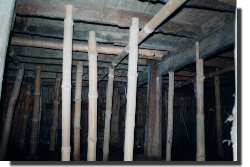 random plant along the path. He would grind the leaves in his hand a bit, and then present us with the
magical smell of cloves, or cinnamon, or peppermint, or some other random spice. Then he would point up and we would see bananas growing all over on the trees above. A little way down the path would be coffee beans, followed by an old-fashioned bean-grinding mill powered by a water wheel. It was just like what we tourists wanted to see and it was so easy for the guides to present it to us. Next came the meeting houses, palaces, and old houses.
random plant along the path. He would grind the leaves in his hand a bit, and then present us with the
magical smell of cloves, or cinnamon, or peppermint, or some other random spice. Then he would point up and we would see bananas growing all over on the trees above. A little way down the path would be coffee beans, followed by an old-fashioned bean-grinding mill powered by a water wheel. It was just like what we tourists wanted to see and it was so easy for the guides to present it to us. Next came the meeting houses, palaces, and old houses.
Indonesian Architecture
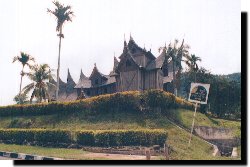 Wall Detail
I think one of the biggest draws for Indonesia besides the white beaches and headhunter natives in masks, is the architecture. You know, those wacky buildings with the smiling roofs with the ends turned up for no reason other than sheer beauty. Well, it turns out that only a few old homes, public houses, and religious buildings have this fancy style, but they definitely do not disappoint. I was amazed by the craftsmanship of the wood construction.
I also love the fact that the buildings were built off the ground on stilts to keep the monsoons out and allow for better natural cooling of the living space. We saw one huge old home which had seven rooms for the six daughters (I guess the other was for the mother). It was a beautiful, quiet building, very cool despite the heat outside. Our guide took the opportunity to tell us about some of the Minang Kabau culture and customs: Wall Detail
I think one of the biggest draws for Indonesia besides the white beaches and headhunter natives in masks, is the architecture. You know, those wacky buildings with the smiling roofs with the ends turned up for no reason other than sheer beauty. Well, it turns out that only a few old homes, public houses, and religious buildings have this fancy style, but they definitely do not disappoint. I was amazed by the craftsmanship of the wood construction.
I also love the fact that the buildings were built off the ground on stilts to keep the monsoons out and allow for better natural cooling of the living space. We saw one huge old home which had seven rooms for the six daughters (I guess the other was for the mother). It was a beautiful, quiet building, very cool despite the heat outside. Our guide took the opportunity to tell us about some of the Minang Kabau culture and customs:
Minang Kabau
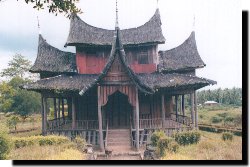 The group gets its name from some bull fight long ago where the people from Java came up with their biggest bull to fight the local people in central Sumatra. This area has no fierce animals, so the people had to use some cunning (and a little cheating, if you ask me) in order to win. The surprised Javanese losers named the locals the "winning bull" or Minang Kabau people. Tourists, travelers, anthropologists and others have been intrigued by this story and others that surround the mystical history of the Minang Kabau. One of the most-talked about issues is the matriarchal nature of the people which Eugene describes quite well. Jon also told us about the dating and marriage customs a bit. Two people from the same clan cannot get married, he says. It is the job of each clan leader to hold special meetings to discuss the propriety of a member marrying another clan member. These discussions are usually held in the grand meeting house (photo at top) of the woman's clan. I don't think that any wedding was ever held up due to clan problems, and the whole importance of the clan seems to be declining. However, it is still popular for young people to ask each other, maybe on the second or third date, what clan each is from. If the new love interest is from the same clan, or maybe an opposing clan, then the relationship may end before getting started. Wanting to conform to local custom, Eugene and I used "What's your clan?" as the official pick-up line for the remainder of the trip.
The group gets its name from some bull fight long ago where the people from Java came up with their biggest bull to fight the local people in central Sumatra. This area has no fierce animals, so the people had to use some cunning (and a little cheating, if you ask me) in order to win. The surprised Javanese losers named the locals the "winning bull" or Minang Kabau people. Tourists, travelers, anthropologists and others have been intrigued by this story and others that surround the mystical history of the Minang Kabau. One of the most-talked about issues is the matriarchal nature of the people which Eugene describes quite well. Jon also told us about the dating and marriage customs a bit. Two people from the same clan cannot get married, he says. It is the job of each clan leader to hold special meetings to discuss the propriety of a member marrying another clan member. These discussions are usually held in the grand meeting house (photo at top) of the woman's clan. I don't think that any wedding was ever held up due to clan problems, and the whole importance of the clan seems to be declining. However, it is still popular for young people to ask each other, maybe on the second or third date, what clan each is from. If the new love interest is from the same clan, or maybe an opposing clan, then the relationship may end before getting started. Wanting to conform to local custom, Eugene and I used "What's your clan?" as the official pick-up line for the remainder of the trip.
Over the Pass and Into Maninjau
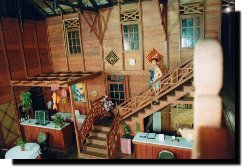 After a long day of touring the countryside, there is nothing better than a good SRO bus ride. No sooner had we gotten on this packed minibus than the driver stopped to fix a flat tire. He then proceeded to jack up the bus and replace the rear tire while the passengers were still inside! Finally we were on the road and swaying back and forth around the 44 switchbacks of the final decent into Maninjau. Lake Maninjau, like Lake Toba, was created when the crater of a volcano filled up into a
After a long day of touring the countryside, there is nothing better than a good SRO bus ride. No sooner had we gotten on this packed minibus than the driver stopped to fix a flat tire. He then proceeded to jack up the bus and replace the rear tire while the passengers were still inside! Finally we were on the road and swaying back and forth around the 44 switchbacks of the final decent into Maninjau. Lake Maninjau, like Lake Toba, was created when the crater of a volcano filled up into a
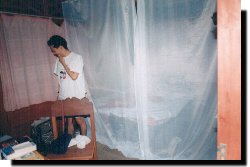 lake. Lake Toba's volcano is credited (by some) for causing the last ice age. Lake Maninjau, at about 50km around, is no small hole either. Anyway, being in the mountains, the weather is ideal for a quiet weekend getaway. Due to the economic and political climate now, the village was as quiet as most of the tourist sites. We were the only ones staying at the Alam Maninjau, perched up on the hillside looking over the lake. Given the time, I could have stayed here for a week, or a month. It was the perfect place to hide away.
lake. Lake Toba's volcano is credited (by some) for causing the last ice age. Lake Maninjau, at about 50km around, is no small hole either. Anyway, being in the mountains, the weather is ideal for a quiet weekend getaway. Due to the economic and political climate now, the village was as quiet as most of the tourist sites. We were the only ones staying at the Alam Maninjau, perched up on the hillside looking over the lake. Given the time, I could have stayed here for a week, or a month. It was the perfect place to hide away.
Biking in the Hills round Maninjau
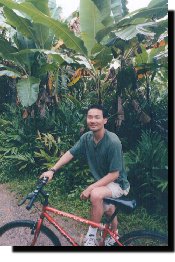
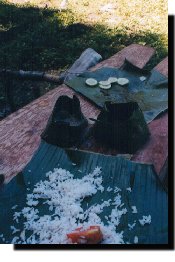 The enterprising locals have started to rent mountain bikes in addition to running their guesthouse/restaurtant/convenient stores and also providing tourguides and other local information. I wanted to take the (sometimes rocky) road around the lake to enjoy the area at a different pace, but Euge and I got dumped on by some afternoon rain just after starting. We found refuge with some other
travelers at some roadside rest area/prayer house type place. After some deliberation, we decided to give up and settle for a short ride up in the hills instead. I think this was a good decision. As the lake was formed in the crater of an old volcano, the road around the edge is quite flat while any road away from the main thoroughfare runs uphill. The multi-geared mountain bikes were well-equiped for the ride, but the roads quickly deteriorated into rocks and washed-out hillside dirt paths. Given a week here and a slightly better bicycle, one could have a lot of fun exploring the surrounding forrests and villages. Since we were still wet and tired we decided to head back in for dinner and discussion with our new friend Yanti.
The enterprising locals have started to rent mountain bikes in addition to running their guesthouse/restaurtant/convenient stores and also providing tourguides and other local information. I wanted to take the (sometimes rocky) road around the lake to enjoy the area at a different pace, but Euge and I got dumped on by some afternoon rain just after starting. We found refuge with some other
travelers at some roadside rest area/prayer house type place. After some deliberation, we decided to give up and settle for a short ride up in the hills instead. I think this was a good decision. As the lake was formed in the crater of an old volcano, the road around the edge is quite flat while any road away from the main thoroughfare runs uphill. The multi-geared mountain bikes were well-equiped for the ride, but the roads quickly deteriorated into rocks and washed-out hillside dirt paths. Given a week here and a slightly better bicycle, one could have a lot of fun exploring the surrounding forrests and villages. Since we were still wet and tired we decided to head back in for dinner and discussion with our new friend Yanti.
View this QTVR Panorama of Biking in the Hillside(333K)

Hiking in the "Wild Jungle" of Maninjau
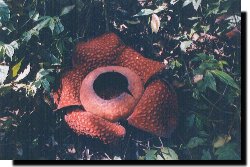
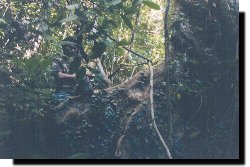 If you are going to head for the forests, though, hiking is the way to go. The next day, I found a private guide name Hendri to show me around the area a bit. This was definitely my most impressive "jungle tour" yet. We hadn't walked twenty minutes into the forest before we saw monkeys jumping around in the treetops overhead. Next Hendri spotted a jungle cat, but I think it was just some imaginary animal.
Anyway, the vegetation was truly thick and wet and although we were on a path, Hendri had to cut away some brush with his machete. I even got a few leeches sucking blood through my thick socks. The finale for the morning walk was a look at the mysterious Rafflesia, the biggest flower in the world. It only flowers once a year, so I was lucky to see a very fine specimen out in the wild. After a couple hours of walking, it felt great to have a massage under a tall cold waterfall. On the way back to town, we had a fabulous lunch which Juni had carried in little leaf-pouches. It included rice, veggies, and sweet banana flowers soaked in coconut milk and spices. Very good stuff. Juni even took me by his house for some tea and relaxation. I got to hang out with his family for a bit while he went through his Muslim prayer ritual for the morning. Overall, the tour was pretty short and a little expensive, but it was a nice way to see a different side of Maninjau. Next time I would like to really get out and see this area more; it was one of the most beautiful things on the whole trip.
If you are going to head for the forests, though, hiking is the way to go. The next day, I found a private guide name Hendri to show me around the area a bit. This was definitely my most impressive "jungle tour" yet. We hadn't walked twenty minutes into the forest before we saw monkeys jumping around in the treetops overhead. Next Hendri spotted a jungle cat, but I think it was just some imaginary animal.
Anyway, the vegetation was truly thick and wet and although we were on a path, Hendri had to cut away some brush with his machete. I even got a few leeches sucking blood through my thick socks. The finale for the morning walk was a look at the mysterious Rafflesia, the biggest flower in the world. It only flowers once a year, so I was lucky to see a very fine specimen out in the wild. After a couple hours of walking, it felt great to have a massage under a tall cold waterfall. On the way back to town, we had a fabulous lunch which Juni had carried in little leaf-pouches. It included rice, veggies, and sweet banana flowers soaked in coconut milk and spices. Very good stuff. Juni even took me by his house for some tea and relaxation. I got to hang out with his family for a bit while he went through his Muslim prayer ritual for the morning. Overall, the tour was pretty short and a little expensive, but it was a nice way to see a different side of Maninjau. Next time I would like to really get out and see this area more; it was one of the most beautiful things on the whole trip.
View this QTVR Panorama Image from the "Jungle" Trek(190K)

Hanging out with Yanti
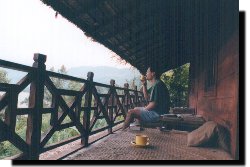 You would think the locals would get tired of the constant flow of rich tourists through their relatively poor area, but some areas just seem to receive visitors better than others. As one tour guide put it, "The Minang Kabau people live in very beautiful land, so many people want to visit. We are proud to show them about our food, buildings, and living environment." They also like the money. Anyway, Eugene and I were lucky enough to meet a good friend in Maninja. Yanti just happened to be staying at our guesthouse for a couple days as she was passing through town and visiting her mother. Currently Yanti is studying English at a school in Padang, the second-largest city in Sumatra. She was a bit shy about speaking when we first met her at the guesthouse restaurant, but we soon got to know
You would think the locals would get tired of the constant flow of rich tourists through their relatively poor area, but some areas just seem to receive visitors better than others. As one tour guide put it, "The Minang Kabau people live in very beautiful land, so many people want to visit. We are proud to show them about our food, buildings, and living environment." They also like the money. Anyway, Eugene and I were lucky enough to meet a good friend in Maninja. Yanti just happened to be staying at our guesthouse for a couple days as she was passing through town and visiting her mother. Currently Yanti is studying English at a school in Padang, the second-largest city in Sumatra. She was a bit shy about speaking when we first met her at the guesthouse restaurant, but we soon got to know
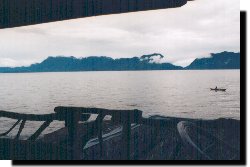 her, if only a little bit. She accompanied us on our bus back to Bukittinggi and took us on a little shopping spree of the market there. I came away with a used pair of dress pants for work, and Euge got some stones and a slick haircut. Our time together, was short, but it was nice to personalize the visit a bit. Of course, Euge made false promises about our coming back in a few years, so we parted on good terms. Unfortunately, Yanti's choice of a night bus out of the city was not so well-informed, and later we would curse her for sending us down a rocky path. But otherwise, we have only fond memories of Yanti.
her, if only a little bit. She accompanied us on our bus back to Bukittinggi and took us on a little shopping spree of the market there. I came away with a used pair of dress pants for work, and Euge got some stones and a slick haircut. Our time together, was short, but it was nice to personalize the visit a bit. Of course, Euge made false promises about our coming back in a few years, so we parted on good terms. Unfortunately, Yanti's choice of a night bus out of the city was not so well-informed, and later we would curse her for sending us down a rocky path. But otherwise, we have only fond memories of Yanti.
|

















